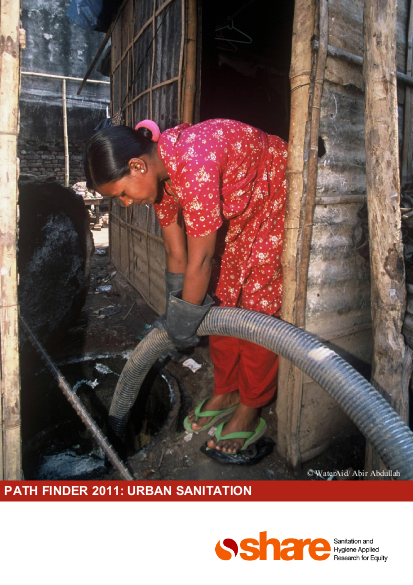
This paper discusses the common constraints to the provision of improved sanitation services to people living in low-income urban communities in Africa and makes suggestions on improved practice. The paper also highlights the current research gaps that SHARE could potentially examine over the next five years. Over the years, both African and Asian countries have faced enormous backlogs in the provision of sanitation services, especially in urban poor communities, resulting partly from the use of inappropriate service approaches. This is coupled with limited financial resources and rapid urbanisation and population growth. This paper also shows that for the Millennium Development Goal target on sanitation to be achieved, there is need to develop effective links between communities and sanitation agencies and to use cheaper alternative sanitation technologies. Areas where sanitation improvements have been made there is normally a good relationship between the communities and the authorities. This paper is based on literature, work experience, interviews and SHARE country visits. The paper also draws on a paper presented by the author at the 2nd International Congress on `Wastewater Treatment in Small Communities‘ in Seville in 2007. Although this paper touches on health and hygiene, equity and sanitation markets, it does not discuss them in great depth as these themes will be addressed in other pathfinder papers. The paper is broken down as follows: Section I: This section provides a brief overview of the sanitation situation globally and in Asia and Africa. The latest statistics showing access to basic sanitation coverage in the SHARE priority countries are presented. This section also looks at the current sanitation systems in use in urban settings of Africa and Asia. Desludging, wastewater and solid waste management are also discussed. This section concludes with a discussion of the challenges to sanitation in low-income countries. Section II: In this section, suggestions for improved planning and practice in the sanitation sector in low-income countries are presented. Section III: In Section III, the research gaps and questions in urban sanitation are presented.
Resource collections
- UN Habitat - Urban Response Collection
- Urban Response - Urban Crisis Preparedness and Risk Reduction
- Urban Response Collection - Community Engagement and Social Cohesion
- Urban Response Collection - Economic Recovery
- Urban Response Collection - Environment and Climate Change
- Urban Response Collection - Housing, Land and Property
- Urban Response Collection - Urban Crisis Response, Recovery and Reconstruction
- Urban Response Collection - Urban Resilience